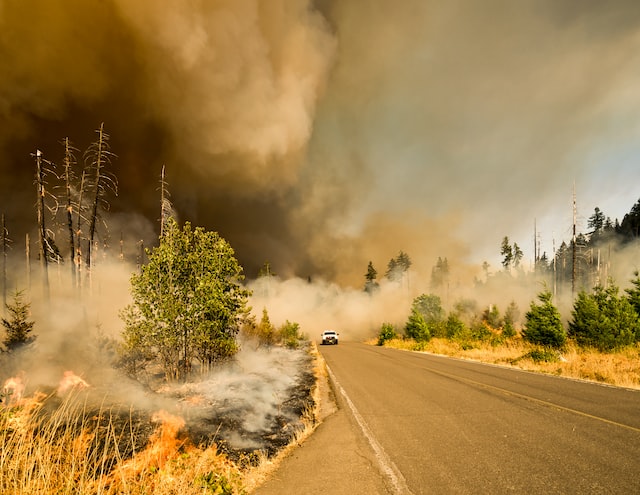
Wildfires in both the US and Europe have exploded in magnitude and severity over the last decade. While wildfires inflict direct damage to life and property, smoke from the fires can drift thousands of miles, deteriorating air quality far from the fires themselves. Little is known about the extent to which air pollution affects the functioning and well-being of working-age adults.
We examine the effect of drifting wildfire smoke plumes on earnings, employment, and labor force participation across the US. A challenge to identify the causal effects of air pollution on labor market outcomes is that labor market activity itself can produce pollution, such as through vehicle and manufacturing emissions. Naturally drifting wildfire smoke plumes provide an opportunity to overcome this challenge. By analyzing the effects of smoke events, we can infer both the damages done by wildfires and how air pollution affects the labor market more generally.
Smoke exposure significantly increases concentrations of air pollutants, including fine particulate matter (PM2.5) thought to be particularly harmful to human health. On days when a county is covered by a smoke plume, local PM2.5 concentrations increase on average by 2.2 µg/m3, about 23 percentage points. At the quarterly level, one additional day of smoke increases the quarterly PM2.5 average by 0.06 µg/m3. Many of these increases remain below the thresholds for Environmental Protection Agency (EPA) action. Smoke events are also quite common, affecting counties about 20 days per year on average in 2007–2019.
Smoke exposure lowers earnings, employment, and labor force participation. An additional day of smoke exposure reduces local quarterly per capita earnings by $5.20, or about $103 per 1 µg/m3 increase in the quarterly average PM2.5. Applying these estimates of marginal damage to the average smoke exposure implies that smoke reduced US labor income by 2 percent per year. This effect is large and suggests wildfire smoke may be more harmful than other types of particulate matter. Earnings losses are largest at older ages, consistent with either a greater responsiveness to air pollution or greater vulnerability to labor market shocks among older adults.
One reason that temporary shocks to air quality could have large effects on the labor market is through labor market disruptions associated with job loss and labor force dropout. For a 1 µg/m3 increase in the quarterly average PM2.5, employment declines by about 1,750 per million residents aged 16 and older while labor force participation declines by around 800 individuals per million. These findings accord with evidence from prior studies of displaced workers showing that job transitions can induce long-term effects on earnings and employment, especially among middle-aged and older workers.
We benchmark the labor market effects of air pollution exposure to conventional mortality-based measures of the costs. Losses in the labor market exceed reasonable estimates of the mortality consequences of smoke exposure based on commonly used values of statistical life. Our estimates contrast with current EPA, OECD, and World Bank assessments which have put the labor market costs of air pollution to be 5% or less than the premature mortality costs. These prior estimates largely rely on strong modeling assumptions, for example, by assuming that lost work arises due to mortality in the working-age population.
There are three main lessons for researchers and policymakers. First, the damage from wildfires extends far beyond the fires themselves. This damage represents an externality, pointing to a need for cross-regional coordination in setting policy around firefighting and prevention and land use at the wilderness–urban interface. Second, assessments of the social welfare costs of air pollution (and environmental shocks, more generally) should account for labor market effects, a margin that has received growing interest from researchers over the last decade. Improvements in labor market outcomes influence the cost–benefit analysis of environmental regulations by reducing the deadweight burden of labor taxation. Third, the findings point to gains from mitigative actions people can take in response to wildfire smoke, such as air filtration in homes, workplaces, and schools, as well as improvements in and greater reliance on forecasts of air quality. Actions taken to avoid smoke exposure will need to increase in the coming decades, as wildfires and wildfire smoke are projected to increase in severity and frequency with the changing climate.
© Mark Borgschulte, David Molitor, and Eric Yongchen Zou
Mark Borgschulte is assistant professor of economics, University of Illinois Urbana-Champaign, and a Research Affiliate of IZA.
David Molitor is associate professor of finance and economics, University of Illinois Urbana-Champaign, and a Research Associate of the NBER.
Eric Yongchen Zou is assistant professor of economics, University of Oregon, and a Faculty Research Fellow of the NBER.
Please note:
We recognize that IZA World of Labor articles may prompt discussion and possibly controversy. Opinion pieces, such as the one above, capture ideas and debates concisely, and anchor them with real-world examples. Opinions stated here do not necessarily reflect those of the IZA.